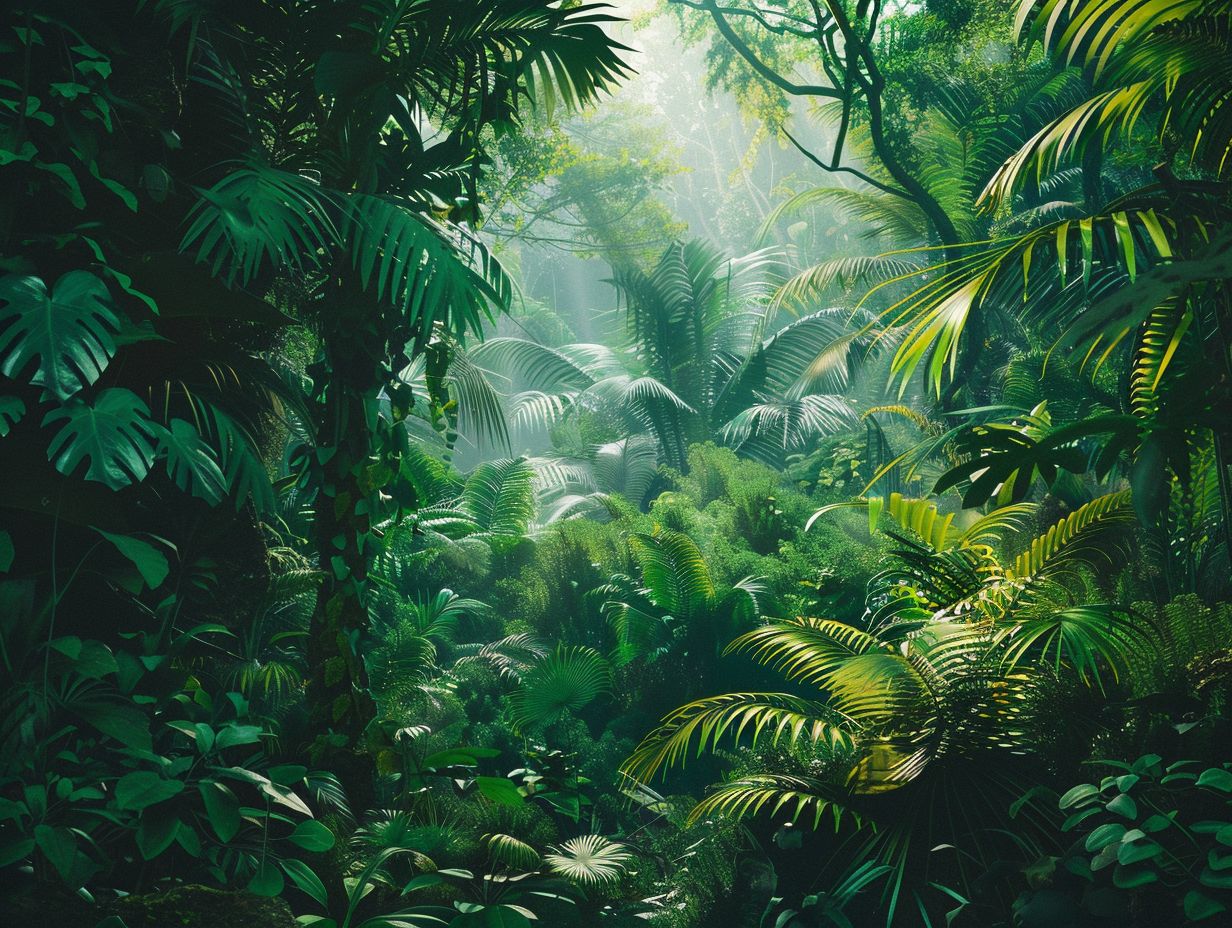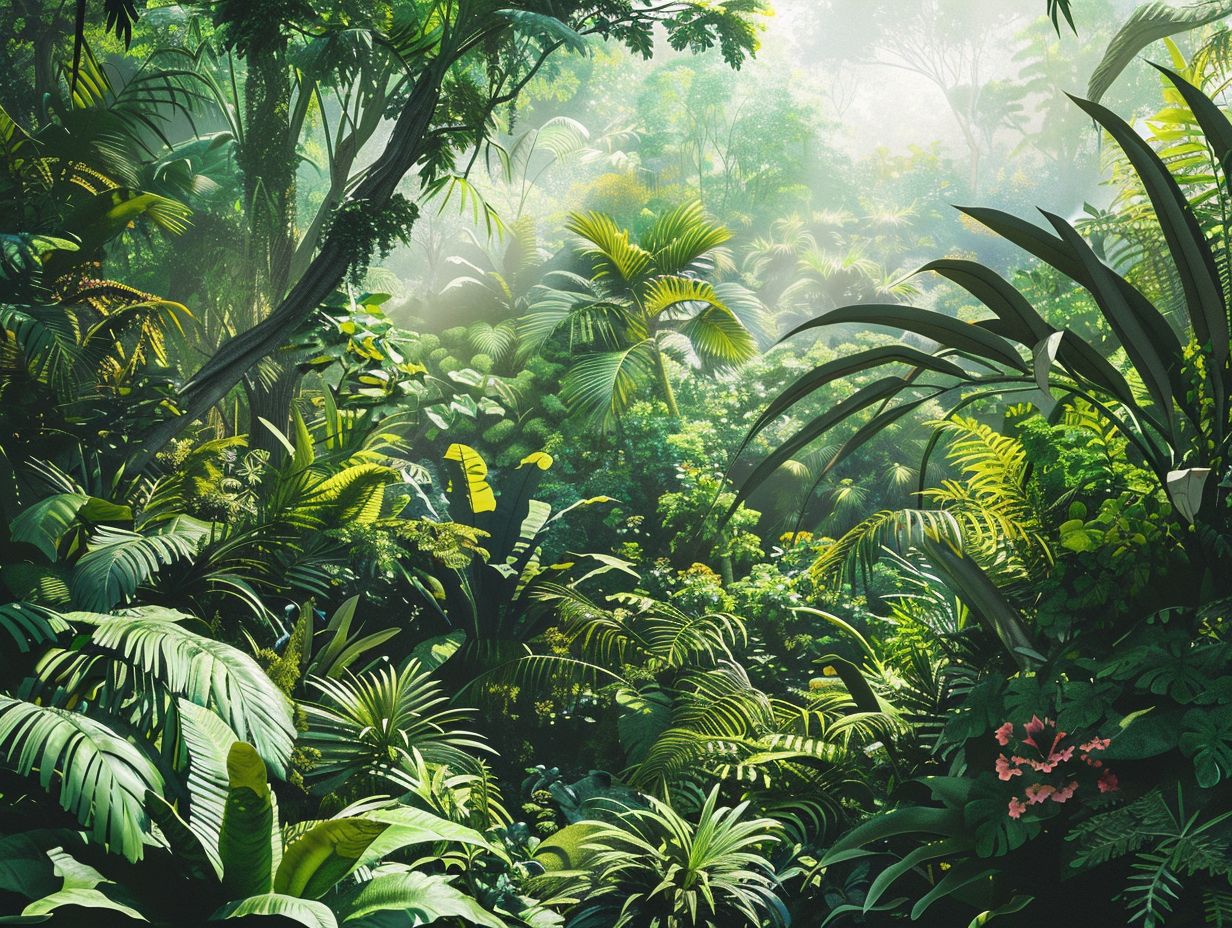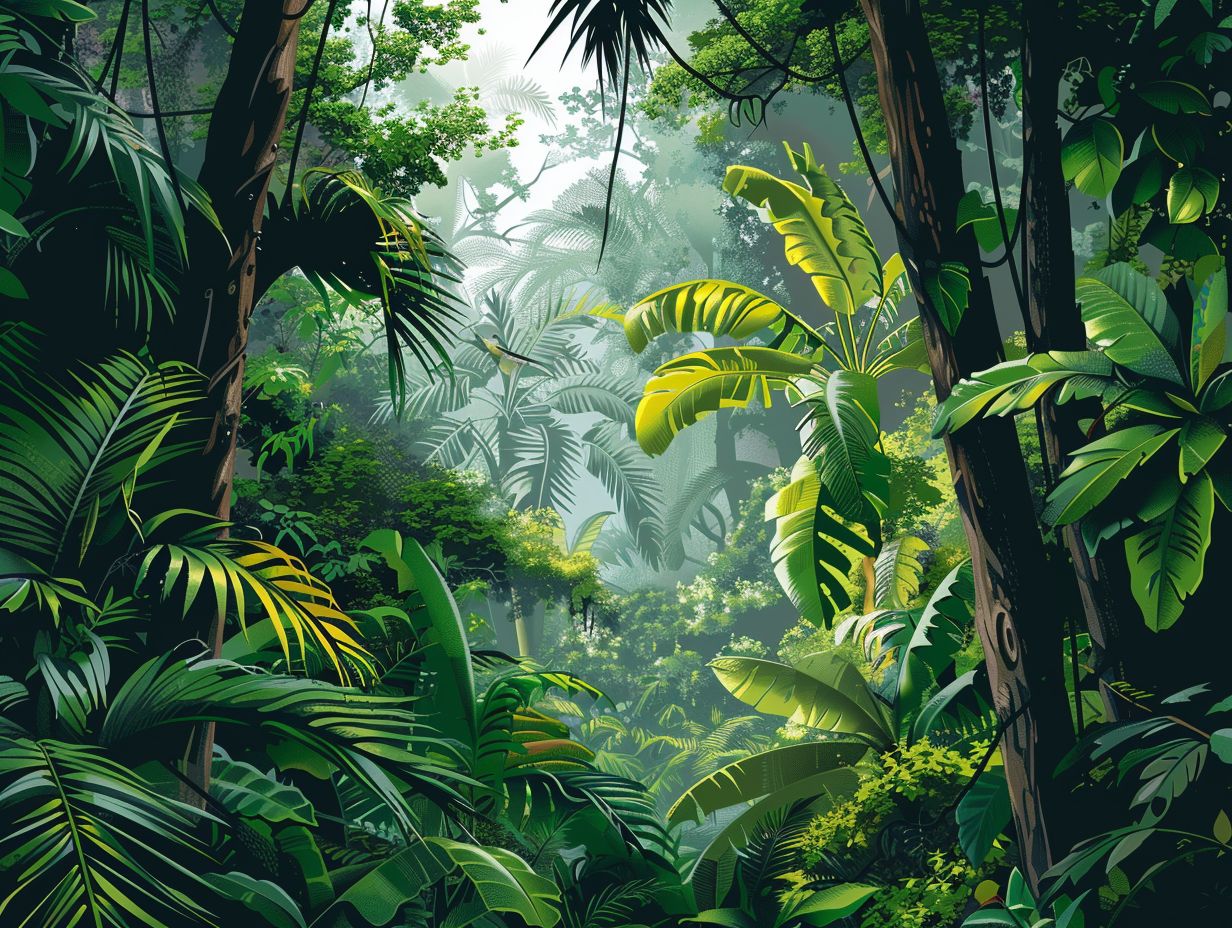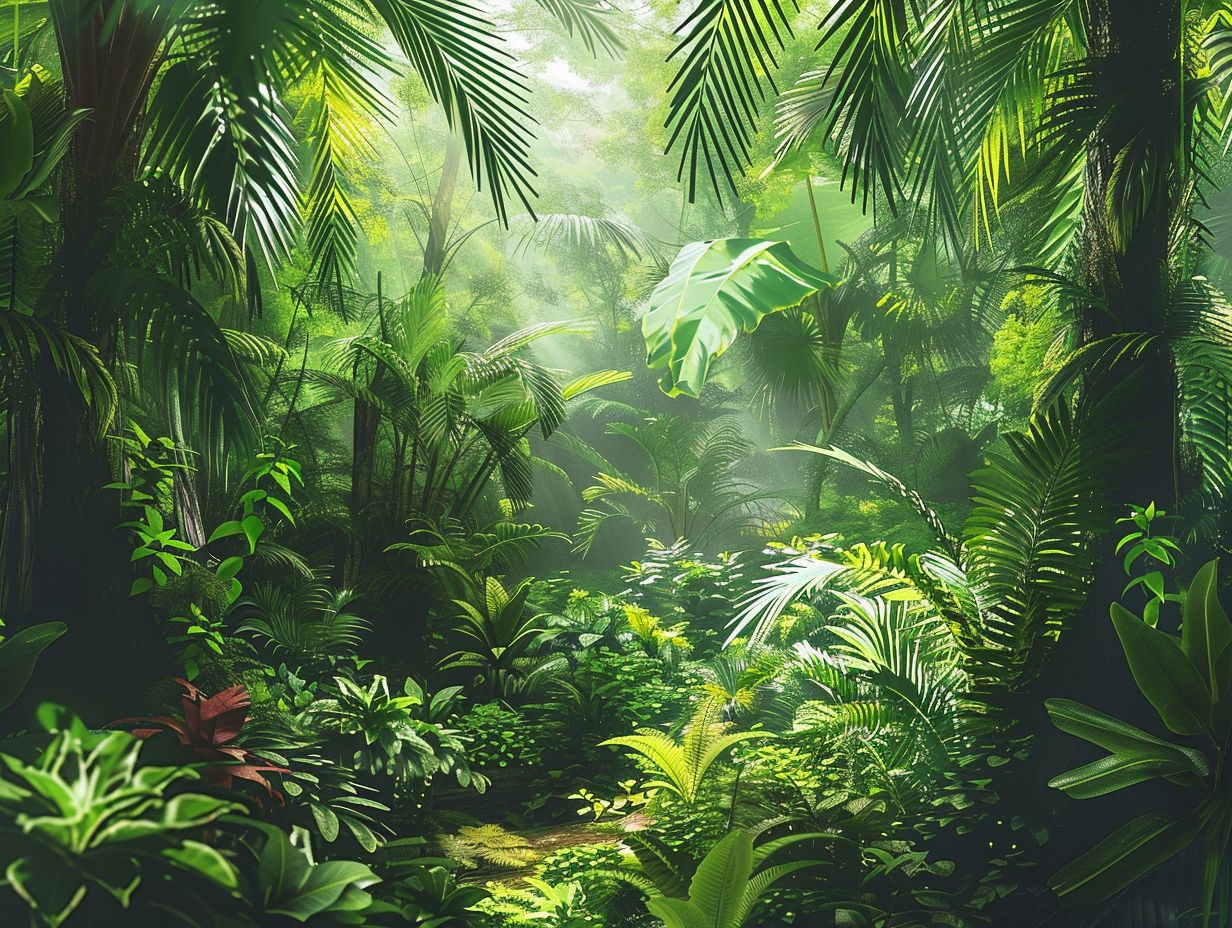
Rainforest Zone Kilimanjaro
Discover the lush and vibrant Rainforest Zone on Mount Kilimanjaro, a unique ecosystem teeming with diverse flora and fauna.
Explore the wonders of this enchanting region, from the average temperature to the terrain and wildlife. Delve into the challenges of hiking through the dense vegetation, the hazards to watch out for, and the physical demands of the trek.
Uncover the highlights and must-see sights, as well as the cultural and historical significance of the Rainforest Zone.
Learn about the conservation efforts aimed at preserving this precious environment.
Key Takeaways:

- The Rainforest Zone on Mount Kilimanjaro is a stunning and diverse ecosystem, home to a variety of plants and animals.
- The climate in the Rainforest Zone is warm and humid, with heavy rainfall and lush greenery. Hiking through this zone requires preparation for physical demands and potential hazards.
- Conservation efforts in the Rainforest Zone are crucial to preserving its rich biodiversity and cultural significance. Visitors can also enjoy unique photo opportunities and learn about the history of the area.
What is the Rainforest Zone on Mount Kilimanjaro?
The Rainforest Zone on Mount Kilimanjaro is a lush and vibrant area characterized by dense foliage, diverse flora, and a variety of wildlife species such as monkeys and birds.
The Rainforest Zone boasts an incredible array of plant life, including tall trees like mahogany and ebony, vibrant orchids, and broad-leaved ferns that thrive in the humid conditions. The canopy above forms a dense layer allowing only scattered sunlight to filter through, creating a unique microclimate below. This environment supports a plethora of animals, from colorful butterflies to elusive leopards and playful colobus monkeys swinging effortlessly through the branches.
Where is the Rainforest Zone Located on Mount Kilimanjaro?
The Rainforest Zone on Mount Kilimanjaro is situated at the lower altitudes of the mountain, primarily on the southeastern slopes in Tanzania.
This lush and vibrant ecosystem is characterized by its dense vegetation, with a canopy of towering trees that provide shelter for a diverse array of flora and fauna. As one descends from the arid upper reaches of Kilimanjaro, the transition into the Rainforest Zone is striking, with the landscape transforming into a verdant paradise teeming with life.
The Rainforest Zone plays a crucial role in the mountain’s ecosystem, serving as a vital source of moisture and oxygen production. The high levels of precipitation in this region contribute to the abundant growth of mosses, ferns, and epiphytes, creating a rich tapestry of plant life.
What is the Climate and Weather in the Rainforest Zone?
The Rainforest Zone on Mount Kilimanjaro experiences a humid and tropical climate, with abundant rainfall throughout the year supporting a diverse range of ecosystems and seasonal variations.
The average temperature in the Rainforest Zone typically ranges between 20 to 25 degrees Celsius, creating a warm and humid environment. This climatic condition is ideal for the growth of lush vegetation, with dense canopies providing shelter and sustenance for various plant and animal species.
Rainfall patterns in this zone are characterized by consistent and heavy precipitation, often exceeding 2000 mm annually. The high levels of rainfall contribute to the fertility of the soil and promote rapid growth of vegetation, fostering a rich biodiversity.
The wet and damp conditions of the Rainforest Zone not only nurture a variety of plants like ferns, orchids, and giant trees but also support a diverse wildlife population, including primates, birds, and insects. The constant moisture and warmth create an ideal habitat for endemic species to thrive within the dense vegetation.
What is the Average Temperature in the Rainforest Zone?
The average temperature in the Rainforest Zone of Mount Kilimanjaro ranges between X and Y degrees Celsius, influenced by the altitude and diverse ecosystems present.
As one ascends to higher altitudes on Mount Kilimanjaro, the temperature gradually decreases. Altitude plays a significant role in altering the climate of the Rainforest Zone. For every 1,000 meters in altitude gain, there is an average temperature drop of approximately 6.5 degrees Celsius. This phenomenon creates distinct temperature variations within the different ecological zones of the mountain.
What is the Average Rainfall in the Rainforest Zone?

The Rainforest Zone on Mount Kilimanjaro receives an average annual rainfall of Z millimeters, contributing to its lush vegetation and vibrant ecosystem that thrives on the regular precipitation.
The rainfall patterns in this region follow a distinct seasonal cycle, with heavy rains typically occurring during the wet season, nurturing the rich biodiversity that calls this zone home.
During the drier months, the forest canopy retains moisture, sustaining the flora and fauna through the dry spells. This consistent supply of precipitation is crucial for the survival of endemic plant species like orchids, epiphytes, and towering trees that form the dense canopy providing shelter for a myriad of animal species.
What is the Terrain Like in the Rainforest Zone?
The terrain in the Rainforest Zone of Mount Kilimanjaro is characterized by dense jungles, rich in a variety of plant species, and inhabited by diverse wildlife.
This lush environment is a tapestry of towering trees like mahogany and ebony, intertwined with vibrant ferns and orchids that thrive in the humid climate.
Vines dangle from above, creating natural pathways for monkeys and birds to move effortlessly through the dense canopy.
The forest floor is a carpet of fallen leaves, home to insects, fungi, and small mammals that scurry among the roots of giant fig trees.
What Types of Trees and Plants Can Be Found in the Rainforest Zone?
The Rainforest Zone on Mount Kilimanjaro boasts a diverse array of trees and plant species, including lush vegetation such as X, Y, and Z that thrive in the humid and fertile environment.
One of the iconic tree species found in this zone is the towering African mahogany, with its wide canopy providing shade for the vibrant undergrowth below. The pristine mountain rainforest is home to the majestic Strangler Fig tree, which plays a crucial role in the intricate canopy dynamics and supports various epiphytes.
The indigenous **Orchids** sprinkled throughout the forest floor add a touch of color and elegance to the lush green backdrop. Unique fern species like Frilly Maidenhair ferns can be spotted nestled near streams, showcasing their preference for moist environments.
What Types of Animals Can Be Found in the Rainforest Zone?
The Rainforest Zone on Mount Kilimanjaro is home to a diverse range of animal species, including monkeys and colorful birds being prominent inhabitants of this vibrant ecosystem.
Among the acrobatic monkeys swinging through the dense canopy are the playful Colobus monkeys, known for their striking black-and-white fur that elegantly flows as they move gracefully from branch to branch. These monkeys engage in social grooming rituals and communicate through a series of calls that echo through the treetops, creating a lively atmosphere.
The iridescent plumage of various bird species, such as the prolific African parrots, adds a splash of color to the verdant landscape. Their melodic songs intertwine with the rustling leaves and trickling streams, forming a symphony of sounds that reverberates across the Rainforest Zone.
What Are the Challenges of Hiking Through the Rainforest Zone?
Hiking through the Rainforest Zone on Mount Kilimanjaro presents various challenges, including navigating dense vegetation, encountering slippery terrain, and coping with the high humidity levels.
As hikers venture into the Rainforest Zone, they must also be wary of unpredictable weather changes which can lead to sudden downpours, making the trails even more challenging to traverse.
The dense canopy above often dims the sunlight, creating shadowy patches that can obscure obstacles on the path, demanding constant vigilance. The lush vegetation can conceal potential hazards like tree roots and rocks, increasing the risk of tripping or slipping. To mitigate these risks, trekkers are advised to wear sturdy, waterproof footwear and carry essential gear like trekking poles for stability.
What are the Hazards to Watch Out for in the Rainforest Zone?

Hikers in the Rainforest Zone of Mount Kilimanjaro should be cautious of hazards such as slippery paths, sudden weather changes, and wildlife encounters that may pose risks during the trek.
Slippery paths in the Rainforest Zone can be particularly dangerous due to the lush vegetation and moisture, requiring proper footwear with good grip and cautious footing to prevent falls. Sudden weather changes are common in this region, so hikers should always be prepared with appropriate clothing layers and rain gear. Wildlife encounters, including snakes and insects, can be alarming; it is crucial to maintain a safe distance, move slowly, and avoid disturbing the animals to prevent potential conflicts.
What Are the Physical Demands of Hiking Through the Rainforest Zone?
Trekking through the Rainforest Zone on Mount Kilimanjaro requires considerable physical endurance due to the challenging terrain, steep inclines, and the need to acclimatize to increasing altitudes.
The Rainforest Zone offers a unique mix of dense vegetation and humidity, making the trail slippery and demanding agility and balance. As hikers ascend, the altitude effects become more pronounced, with lower oxygen levels causing fatigue and shortness of breath. Adequate physical fitness plays a crucial role in coping with these challenges, requiring strength in legs for uphill climbs and stamina for long distances.
To minimize altitude sickness, a gradual ascent is recommended, allowing the body to acclimate. It’s essential for trekkers to hydrate well, maintain a steady pace, and listen to their bodies’ signals during the journey.
What Are the Highlights and Must-See Sights in the Rainforest Zone?
The Rainforest Zone on Mount Kilimanjaro offers captivating highlights and must-see sights, from picturesque waterfalls and vibrant flora to unique wildlife encounters that make it a photographer’s paradise.
Exploring the Rainforest Zone immerses you in a lush green world filled with ancient trees and exotic plants, creating a serene atmosphere that feels like stepping into a natural sanctuary. The rhythmic sounds of chirping birds and rustling leaves accompany you as you venture along winding trails, each turn offering a new discovery.
Be sure to visit the mesmerizing Shira Plateau, a striking flat-topped mountain with panoramic views that are simply breathtaking. This area is not only a geological wonder but also holds cultural significance, with local legends enriching the experience of its vast expanse.
What Are the Best Photo Opportunities in the Rainforest Zone?
Photography enthusiasts will find a myriad of captivating photo opportunities in the Rainforest Zone of Mount Kilimanjaro, including close-up shots of exotic flora, colorful bird species, and playful monkeys in their natural habitat.
One of the ideal subjects for photographs in this lush setting is the majestic waterfall cascading down the verdant slopes, creating a mesmerizing contrast against the deep green backdrop. The dappled sunlight filtering through the dense canopy offers a perfect play of light and shadow, enhancing the ethereal beauty of the surroundings.
Immersing oneself in the sights and sounds of the rainforest allows photographers to capture the essence of biodiversity at its finest, with every frame telling a unique story of nature’s grandeur.
What Are the Cultural and Historical Significance of the Rainforest Zone?
The Rainforest Zone holds cultural and historical significance, especially for the indigenous Chagga people, who have long-standing connections to the land and its diverse ecosystem.
The Chagga people have a rich tapestry of traditions that are deeply intertwined with the Rainforest Zone. Their cultural heritage is evident in the way they have harmoniously coexisted with the natural environment for generations, following sustainable practices that have allowed both the community and the ecosystem to thrive.
Through their customs, such as traditional farming methods and spiritual rituals, the Chagga people demonstrate a profound respect for the forest and its inhabitants. These traditions have not only preserved their unique identity but also contributed to the preservation of the biodiverse landscape.
What Are the Conservation Efforts in the Rainforest Zone?

Conservation efforts in the Rainforest Zone of Mount Kilimanjaro focus on preserving the delicate balance of its ecosystem, protecting endangered flora and fauna, and promoting sustainable practices to safeguard the biodiversity of the region.
One of the key conservation projects in this area is the reforestation initiatives, aiming to restore degraded areas and create corridors for wildlife movement.
Ecotourism programs have been introduced to raise awareness about the importance of conservation and provide local communities with alternative sources of income.
Innovative approaches like community-based conservation efforts and biodiversity monitoring systems have also been implemented to ensure long-term sustainability of the Rainforest Zone’s ecosystem.
It’s crucial to understand that preserving this natural habitat is not just essential for environmental balance but also for the well-being of local communities and future generations.
Frequently Asked Questions:
1. What is the Rainforest Zone on Mount Kilimanjaro?
A: The Rainforest Zone on Mount Kilimanjaro is a lush, tropical area that is the first zone hikers encounter when climbing the mountain. It is characterized by dense vegetation, high humidity, and plenty of rainfall.
2. What kind of flora and fauna can be found in the Rainforest Zone Kilimanjaro?
A: The Rainforest Zone is home to a variety of plant and animal species, including ancient trees, colorful birds, and small mammals such as monkeys. Hikers may also spot unique flowers and insects along the way.
3. How long does it take to cross the Rainforest Zone on Kilimanjaro?
A: The Rainforest Zone can take approximately 2-3 days to cross, depending on the pace of the hikers. This zone is typically the first leg of the journey and serves as an acclimatization phase for trekkers.
4. What is the weather like in the Rainforest Zone Kilimanjaro?
A: The weather in the Rainforest Zone is typically warm, humid, and rainy. Temperatures can range from 20-30 degrees Celsius, with high levels of precipitation. It is important for hikers to pack rain gear and be prepared for changing weather conditions.
5. Is the Rainforest Zone Kilimanjaro a protected area?
A: Yes, the Rainforest Zone on Mount Kilimanjaro is a protected area, as it is part of the Kilimanjaro National Park. It is home to many endangered species and is carefully monitored and preserved by park rangers.
6. Are there any cultural or historical significance to the Rainforest Zone Kilimanjaro?
A: Yes, the Rainforest Zone holds cultural and historical significance to the Chagga people, who are the indigenous tribe of Kilimanjaro. This zone was once their ancestral land and is home to sacred sites and traditional practices that are still observed today.